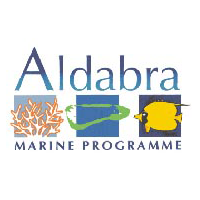The 1998 Coral Bleaching Event at Aldabra
In early 1998, the waters of the Seychelles experienced unseasonably high sea temperatures ranging from 29 to 34 C and exceptionally reaching 37 C in some lagoons.
High sea surface temperatures for the Seychelles were unusually prolonged with temperatures in excess of 30 C persistent for approximately four months in early 1998. This was later confirmed with satellite derived SST data for the region obtained through the Hadley Centre – UK MET Office.
This led to a coral bleaching event that was widely noted in the granitic Seychelles, and was extensive on all the southern Seychelles reefs in 1998. Bleaching was not exclusive to hermatypic corals and incidences of bleaching were widespread in alcyonaceans, non-scleractinian coelenterates (Stichodactyla spp. and Heteractis spp.) and bivalves (Tridacna spp.).
Mortality was particularly high in the branching corals – Acropora spp., Pocillopora spp., Millepora spp. (fire coral) and Heliopora spp. (blue coral). Death in the massive or boulder corals such as Porites spp., Favia spp., Pavona spp. and Diploastrea spp. was in most cases partial and spatially patchy.
In Aldabra, bleaching was generally worse in shallower waters (10m or less). Areas which were least impacted were those influenced by cooler currents and those coral colonies which are found within lagoonal channels where water fluxes are high. Furthermore, coral subjected to frequent high temperatures, such as in lagoons, faired well; thus many of the corals survived in the Aldabra Lagoon suggesting an adaptation of corals there to periodic inundation by high sea temperatures.
The strength of the 1997-98 ENSO, whose growth was more rapid and SST anomalies larger than any other El Niño since 1950, was such that warm water anomalies were significantly strengthened in the tropical Atlantic and Indian Oceans.
The strong and prolonged nature of this warm water SST anomaly in the Western Indian Ocean led to the extensive and pervasive coral bleaching in this region, including the Southern Seychelles. Previous studies have shown that small temperature and short duration excursions above the mean monthly summer maximum result in partial and complete recovery of bleached coral colonies, yet larger temperature changes maintained for prolonged periods, as was the case in 1997-98, lead to the mass mortality of affected corals.
Study of sea surface temperature archives extracted for the Southern Seychelles suggests that a bleaching event of this magnitude has not been witnessed within the last three decades in this area. This is largely based on the assumption that the coral bleaching events occur following a >+1ºC above the mean maximum monthly SST.
Records for Aldabra also indicate that SSTs for 1998 were the highest of the previous three and a half decades (See figure below). Anomalous temperatures began with a rapid increase in SSTs from November 1997 to a +1°C SST anomaly by January 1998. Peak SSTs (30.65°C) were reached in March, representing a +1.31°C anomaly above the long term mean maximum SST for that month. The +1°C anomaly persisted until April 1998 indicating a duration of almost four months (Figure 5). All temperatures recorded for the period leading up to the bleaching event and those following ranged from +0.5 – 1ºC higher than the long term average of the monthly mean maximum temperatures (1961-1997).
Monthly SST anomalies for Aldabra (5-10ºS 45-50ºE), using 1961-1990 baseline. Note the 1997 anomaly.
Monthly mean maximum sea surface temperatures for Aldabra (9-10ºS, 46-47ºE) from September 1997 to July 1998 in comparison to the average monthly mean maximum sea surface temperatures for the period September to July 1961-1996.
In April 1998, at the peak of the coral bleaching event, a Cambridge Coastal Research Unit (CCRU) based research team (SSARP) found that widespread bleaching and mortality was common on the outer reef slopes surveyed (3m-25m) from the western to northeastern sides of Aldabra. Coral coverage was found to be 37% with 41% of those having been bleached or displaying recent mortality. Bleaching intensity in Aldabra was not as high as other areas in the Southern Seychelles as peak warming was 0.5ºC lower than other areas in the region.
Bleaching and related mortality was primarily seen in the branching and tabular species of coral (i.e., Pocillopora and Acropora), and partial to patchy in most massive species (i.e., Porites, Pavona). Bleaching was in some areas confined to a single side of the coral colony.
A high proportion however of the massive species of corals displayed signs of previous mortality indicative of a thick of algal overgrowth and the presence of encrusting and boring invertebrates. As with other areas soft corals had high levels of bleaching and mortality. Although no quantitative data were gathered for the reef communities in the lagoon, extensive observations were made in all of the channels and in the western half of the lagoon.
Most of the coral species found in the channels, with the exception of isolated incidences of branching corals, were observed to be alive and displaying no obvious signs of perturbation. Notably in the channels was the presence of normally deepwater corals (Tubastrea micrantha) which have been displaced to shallow waters as a result of the channel hydrodynamic activity mimicking conditions of the deep water.
This may explain the high survivorship of massive and branching coral colonies in the channels. Lagoonal patch reefs and individual heads of massive coral species displayed very limited bleaching. Distinctive species such as Galaxea, Serioptera, Acropora and Pocillopora were completely bleached and was most often the case with increased distance from the flux of water from the channel.

